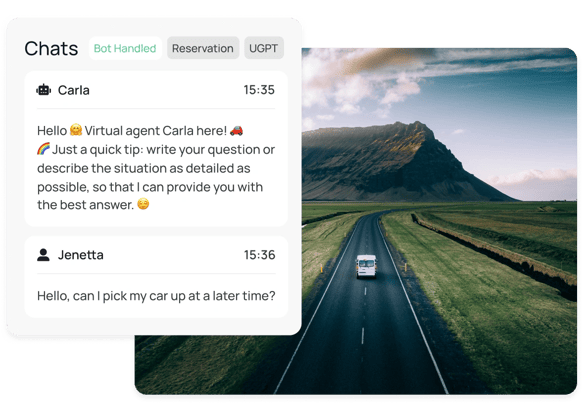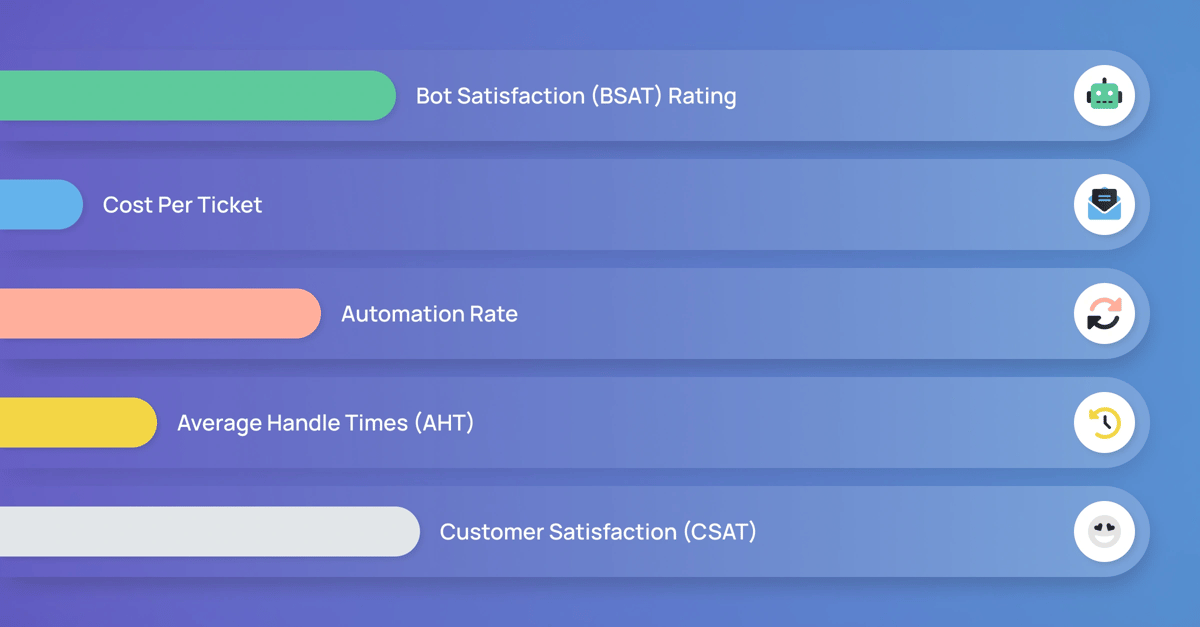By now, you’re probably already familiar with the benefits that the latest AI tools can have for your customer support. Integrating generative AI, for example, will give you the capacity to provide 24/7 multilingual support on the channels your customers love to use – without sacrificing a humanized and on-brand CX. It can also result in cost savings because with a chatbot, you won’t have to hire and train lots of new employees in order to scale.
But despite the promised pros of using AI, how do you know if it’s really working to improve your CX and your bottom line? Do you simply carry on using the same standard metrics for measuring the performance of your support strategy, or are there different ones to consider? As a support automation provider, we get these questions all the time which is why we’ve created this comprehensive roundup of metrics to keep in mind.
This post will cover which new automation KPIs you’ll want to track in the age of AI, as well as what to keep in mind when looking at standard metrics like average handle time (AHT) and customer satisfaction (CSAT).
Top automation KPIs to measure for CX success
1. Bot satisfaction (BSAT) rating
While more general metrics like the traditional CSAT rating are key KPIs for measuring the success of your support, it can be hard to pinpoint how your chatbot figures into any changes in that score after you start automating. That’s why we’ve created the bot satisfaction (BSAT) rating. This metric will allow you to hone in on customer happiness with your chatbot specifically.
This knowledge can then be used to make targeted improvements on precise intents or replies. The measurement is derived from customer ratings, as they will be prompted to score the interaction they had with your chatbot using emojis. You'll be able to see the average BSAT broken down by intent in your analytics dashboard so you can detect what’s currently working well and where improvements can be made in your dialogue flows.
To see how BSAT works without our platform, check out this help center article.
2. Cost per ticket
Cost per ticket is a great way to calculate how much you’re currently spending on support – and how much you could save through automation. In this sense, it’s also a great way to assess the ROI of your automation efforts thus far. Calculate cost per ticket by adding total agent salaries and CRM costs and then dividing it by total ticket volume (note: one ticket = one full interaction from submission to resolution).
This metric has been enormously helpful for our customers in deciphering how much they’ve saved since automating. DiscoverCars, for example, saved a whopping €128k since introducing their chatbot, Carla. Since Carla can do the work of multiple agents and quickly clear their ticket backlog, it has led to a significant reduction in support expenses whilst also providing speedier customer service. You can read their full success story here.
 DiscoverCars' bot, Carla, in action
DiscoverCars' bot, Carla, in action
Learn how automation can make your support team's lives easier
3. Automation rate
Your automation rate is the proportion of tickets out of the total number of queries that your chatbot is able to fully solve without escalating to a human agent. It’s a central metric put forth by CS automation providers, but it’s important to use your critical thinking skills on this one. What we mean is that you should be wary of any platform promising you +80% automation rate immediately after implementing your bot. Rather than take this kind of automation at all costs approach, automation rate is best used as a gradual metric for tracking your automation journey.
As our co-founder Sarah Al-Hussaini advises,
“Opt for realistic targets like achieving 10% automation in month one and then add another 10% in month two, and you’re already making great progress. That’s the sort of journey you should be looking for, rather than rushing to meet arbitrary automation KPIs that sound good on paper but are actually creating worse outcomes for your team and for your customers.”
A good automation provider, therefore, will help you map out an automation journey that makes sense for your business goals and offer some direction on which intents offer the best place to get started when automating. You can find out about our own tailored approach to reaching +60% automation here.
4. Average handle times (AHT)
One of the best benefits of automation is that it can enable you to provide speedier support, around the clock and across all channels – from WhatsApp to social media to email and more. Comparing average handle times before and after you’ve implemented a chatbot can be enormously helpful in assessing how AI has improved your CX. After all, a whopping 72% of customers surveyed by Salesforce say they will opt for the brand that provides the fastest support. When a ticket gets escalated, your bot can also gather info from the customer so that your human agents can hit the ground running when handling the issue – further speeding up AHT.
Assessing a reduction in AHT will also help you to determine ROI of automating because it lets you determine how many agent hours your chatbot is saving you, which then translates into saved headcount and hiring costs. In fact, our customers love this metric, and it is one that is most commonly tracked with respect to determining the success of their automation journey. For example, the online personal styling service, Stitch Fix, was able to slash their AHT by 29% across all their support channels. You can get the full scoop on their automation success here.
5. Customer satisfaction (CSAT)
While BSAT is an amazing tool for precisely assessing the performance of your bot specifically, don’t sleep on traditional metrics like CSAT, which will still give you a holistic view of your CX. And a good CSAT score is best achieved by achieving harmony between your bot and human agents – especially with tools powered by generative AI, which seamlessly mimic human-like conversations. If you have a chatbot on the front lines to provide customers with instant support on their preferred channels and smart escalation paths in place for when queries require a human touch, you will see it reflected in a better overall CSAT.
As we’ve already seen, customers expect speedy service and near instant responses to their queries – to the point that it can really make or break their loyalty to your brand. Automation can, therefore, be a big help when it comes to maintaining – or even improving – a CSAT score that’s well above the benchmark for your industry. Lush offers a case in point. Despite record surges during Black Friday and Royal Mail strikes, they maintained a 93% CSAT with automation. Get their details of their success story here.
The ROI of automating
When it comes to automation, KPIs like AHT and cost per ticket can give you concrete insights into the ROI of automating, by indicating just how much you’re saving with the help of automation. But beyond saving money, it's also important to make sure your customer experience doesn't suffer. These include the bot-specific BSAT, as well as the more holistic CSAT score. Taking a look at a range of different automation KPIs will give you the best sense of how your bot is impacting your brand and your business. And if you want to incorporate an analytics-forward automation platform into your support stack, our automation solution comes complete with comprehensive dashboards for monitoring all the aforementioned KPIs.
